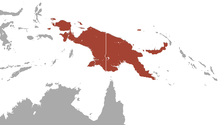| Common echymipera[1] | |
|---|---|
| Scientific classification | |
| Domain: | Eukaryota |
| Kingdom: | Animalia |
| Phylum: | Chordata |
| Class: | Mammalia |
| Infraclass: | Marsupialia |
| Order: | Peramelemorphia |
| Family: | Peramelidae |
| Genus: | Echymipera |
| Species: | E. kalubu
|
| Binomial name | |
| Echymipera kalubu (J. Fischer, 1829)
| |

| |
| Common echymipera range | |
The common echymipera (Echymipera kalubu), or common spiny bandicoot, is a bandicoot. It is long-snouted even by bandicoot standards. The upper parts are a coarse reddish-brown, flecked with spiny buff and black hairs. The tail is short and almost hairless. Length varies between 30 and 40 cm (12 and 16 in), with the tail accounting for an additional 8 to 10 cm (3.1 to 3.9 in); the weight is from 0.6 to 2 kg (1.3 to 4.4 lb).
Names
The name kalubu, from which the scientific name is derived, is from the Ma'ya language of the Raja Ampat Islands.[3]
Distribution
The common echymipera is native to New Guinea. Its presence in the Admiralty Islands is due to human introduction several thousand years ago, but not before 13,000 B.P.[3] However, unlike Phalangeridae species (cuscus), which have historically been widely introduced and distributed by humans, the Peramelidae (bandicoots) have generally not been spread as much via human introductions.[3]
It is hunted for human consumption in New Guinea.[4] The Common echymipera is a host of the Acanthocephalan intestinal parasite Australiformis semoni.[5]
References
- ^ Groves, C. P. (2005). Wilson, D. E.; Reeder, D. M. (eds.). Mammal Species of the World: A Taxonomic and Geographic Reference (3rd ed.). Baltimore: Johns Hopkins University Press. p. 41. ISBN 0-801-88221-4. OCLC 62265494.
- ^ Leary, T.; Wright, D.; Hamilton, S.; Singadan, R.; Menzies, J.; Bonaccorso, F.; Helgen, K.; Seri, L.; Aplin, K.; Dickman, C.; Salas, L. (2016). "Echymipera kalubu". IUCN Red List of Threatened Species. 2016: e.T7018A21966845. doi:10.2305/IUCN.UK.2016-2.RLTS.T7018A21966845.en. Retrieved 12 November 2021.
- ^ a b c Schapper, Antoinette (2011). "Phalanger Facts: Notes on Blust's Marsupial Reconstructions". Oceanic Linguistics. 50 (1): 258–272. doi:10.1353/ol.2011.0004. S2CID 145482148.
- ^ Margaretha Pangau-Adam & Richard Noske & Michael Muehlenberg. Wildmeat or Bushmeat? Subsistence Hunting and Commercial Harvesting in Papua (West New Guinea), Indonesia. Hum Ecol (2012) 40:611–621.doi:10.1007/s10745-012-9492-5
- ^ Schmidt, Gerald D.; Edmonds, Stanley J. (1989). "Australiformis semoni (Linstow, 1898) n. Gen., n. Comb. (Acanthocephala: Moniliformidae) from Marsupials of Australia and New Guinea". The Journal of Parasitology. 75 (2): 215–7. doi:10.2307/3282769. JSTOR 3282769. PMID 2926590.

